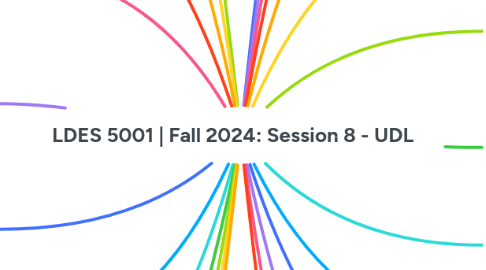LDES 5001 | Fall 2024: Session 8 - UDL
作者:Yianna Vovides

1. How to conduct universal design for learning when educators or designers do not know the audience wellin advance, such as lectures or online courses with a wide audience?
2. Universal design can take into account many elements, but for the design of a course, it is impossible to include all elements. So how can designers make reasonable choices to achieve the best classroom results?
3. If it is known that students belong to a specific group, for example, they all come from the same cultural background, or they all have the same kind of physical problem, how to carry out universal design to make teaching more targeted?
4. Is collaboration among faculty across disciplines to improve the implementation of UDL in higher education possible?
5. How can we be sure that we are addressing the needs of most learners through our design? Is there a criteria of success?
6. How can involving students in tasks like making lecture notes or choosing their assessment methods help them feel they belong and build their learning skills in college?
7. To what extent does traditional pedagogy inadvertently create barriers to learning?
8. Could integrating these perspectives yield a teaching approach that is both structurally accommodating and deeply personal?
9. How can we/should we encourage students to be active participants in UDL?
10. To what extent is it advisable to adapt and adjust things, when students will eventually face a world that does not accommodate each individual’s particularities?
11. Do you agree that ANTM is an example of a quality universal designed educational simulation?
12. How can classes be designed in a way that is inclusive of all students’ access needs, when one student’s needs may directly conflict with the needs of another student?
13. What do you see as the limitations of WHERETO? How might they vary between K-12 students and higher education students?
14. Is allowing students to use ChatGPT and other generative AI bots a type of scaffolding? I think it is.
15. As an instructor, how can I be accessible to students struggling in the class and needing more help?
16. How to design for both intrinsic and extrinsic motivations of students? What strategies can I use?
17. What might be some effective accomodations for neurodiverse students?
18. My question is, since UDL emphasizes flexible assessments, while stage 3 of backward design highlights strategies aligned with specific outcomes. How can we balance these inclusive forms of assessment with clear, outcome-driven goals?
19. Are there any constraints when it comes to implementing UDL in the classroom from lack of funding?
20. Does UDL work best in smaller group of students? Do you think we can create UDL for a group of audiences that we have never met before?
21. To what degree should teachers integrate their personal experiences in the classroom?
22. How can we encourage college instructors with little teacher education to utilize UDL?
23. How can we approach designing for conflicting access needs?
24. What other competition or reality shows do you think show as strong of a universally designed platform?
25. I wonder what can we do to make teachers realize the need for change and inclusion in learning spaces? But also how do we advocate for institutional change within the American education system?
26. I wonder what people's thoughts are about how some schools create separate classes for students with special needs; are there any cases where a separate class for students with declared special needs would actually be better than inclusive classroom learning experiences that meet most students’ access needs, but not all?
27. In what ways do you see UDL as benefitting more than just students with disabilities? How could UDL support traditionally underrepresented student populations?


